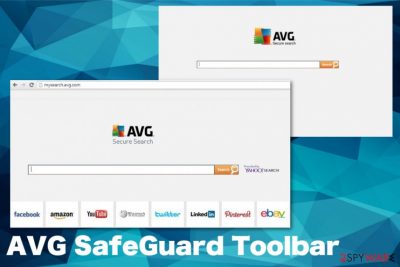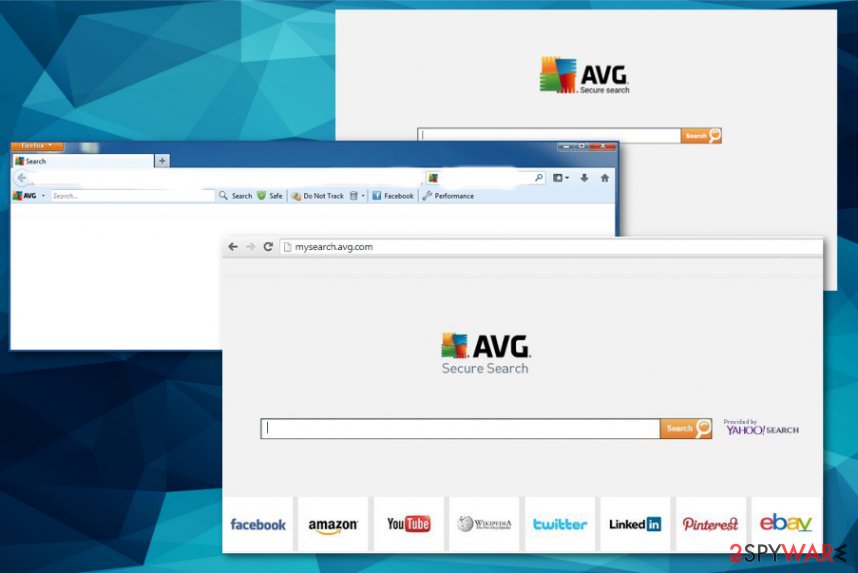AVG SafeGuard Toolbar (Free Guide) - updated Jul 2019
AVG SafeGuard Toolbar Removal Guide
What is AVG SafeGuard Toolbar?
AVG SafeGuard Toolbar is the browser hijacker that redirects all search attempts to mysearch.avg.com engine

AVG SafeGuard Toolbar is the software developed primarily to cause redirects and show content not originating from the website on your commonly visited pages. This is how the PUP generates visits on the pages supported by the same provider. The intruder starts by changing your default search engine to its mysearch.avg.com, adding the same domain as your homepage and new tab, and adding the toolbar on the browser.
Although AVG SafeGuard Toolbar virus is not malicious, it alters results of searches, collects various information about users and can even change parts in the system, interfere with programs and computer settings. These are some major reasons to call it a potentially unwanted program.
| Name | AVG SafeGuard Toolbar |
|---|---|
| Type | Browser hijacker |
| Symptoms | Installs the toolbar, changes browser settings, makes mysearch.avg.com a default search engine, shows questionable results and causes redirects to commercial pages |
| Main danger | Tracks details about users browsing preferences, exposes to possibly malicious content, alters startup settings |
| Distribution | Software bundling, freeware installations, deceptive promotional sites |
| Elimination | Anti-malware tools can help remove AVG SafeGuard Toolbar |
AVG SafeGuard Toolbar is based on browser hijacking that means all the activity happens in the browser when you try to find things online and find all the needed things on the internet. Unfortunately, when the homepage and search engine gets changed, your online searches get injected with useless results and questionable content.
AVG SafeGuard Toolbar shows results filled with commercial pop-ups, banners or even hyperlinks hidden in the text directly. All that activity causes redirects to various sites possibly affiliated to the sponsor or advertiser that focuses on distributing such programs and collecting information about users.
This issue of privacy should raise your attention and note how important is AVG SafeGuard Toolbar removal. Data including your address, location, most viewed items, searched pages, or visited sites gets tracked and collected, so third-party companies can make personalized advertisements and trick you into visiting their sites or purchasing products.[1]
AVG SafeGuard Toolbar is a misleading program that is supposed to protect users from malicious websites, based on the name of security software. Unfortunately, this browser add-on has been recently categorized as a potentially unwanted program and is closely related to browser hijacking.
It was treated as a reliable search provider until it was found out that AVG Secure Search version for some browsers may be affected by cybercriminals who can insert shady codes on user's computers who have installed a version of the toolbar. It was mainly encountered on Internet Explorer but this PUP and any other hijacker can modify Google Chrome, Mozilla Firefox, or any other browsers.[2]

If you have started seeing mysearch.avg.com as your homepage and AVG Secure Search as your default search engine out of nowhere, it means that you have installed the PUP and this is why we still do not recommend using this search site. You can get exposed to similar sites that deliver browser hijackers or adware.
Programs that travel along with popular free software and infiltrates random computer are categorized as potentially unwanted programs and are not recommended using. After getting inside via freeware, AVG SafeGuard Toolbar virus may hijack each of your web browsers, deliver altered search results.
The program tracks your web browsing activities, delivers commercial advertisements and implement other suspicious activities with an intention to create traffic to sponsored websites and earn money from affiliate marketing.
If such hijacker, rogue tool or toolbar has already appeared on your computer, the easiest way to get rid of this hijacker is to run a full system scan with FortectIntego or another reputable anti-spyware. This way your machine gets thoroughly cleaned, and you can remove AVG SafeGuard Toolbar automatically.
As we have already mentioned, AVG SafeGuard Toolbar is a legitimate application that has had some problems with security vulnerabilities. Even though it is stated that these issues are fixed, this toolbar still travels along with popular free software and hijacks all most popular web browsers.

PUP distribution ways
Even though it is not malicious, you should bear in mind that such and similar browser hijackers that are spread using misleading distribution method which is called 'bundling' have some suspicious intentions. In most cases, they seek to build traffic to affiliate websites, generate pay-per-click revenue,[3] increase page rank or sales, and so on.
Therefore, if your search engine and the homepage has been changed and you are experiencing redirects, you should not ignore this because no one knows if it promoted safe websites or not.
If you want to prevent such and similar installers in the future make sure that you always select Advanced or Custom installation option and unmark the check near shady applications like other add-ons, plug-ins or extensions set by default.
Otherwise, you may experience various inconveniences that potentially unwanted programs are capable of causing. This is highly advisable by many international cybersecurity experts.[4]
Get rid of AVG SafeGuard Toolbar virus completely
AVG SafeGuard Toolbar is not a malicious search provider, but if it gets inside in a bundle with other software, you should not rely on it. That's because it may try to promote questionable websites, track your online activities, and do other suspicious operations.
In order to get rid of it, you need to pay more attention than those freeware installations. AVG SafeGuard Toolbar removal requires attention to details and professional anti-malware tools that can check the system fully not only for malware but for suspicious files and apps too.
Get anti-malware tool, preferably from a legitimate source and scan the machine. Then you can follow the suggested steps when the program gets indicated as dangerous and remove AVG SafeGuard Toolbar from the machine alongside other questionable programs or corrupted files.
You may remove virus damage with a help of FortectIntego. SpyHunter 5Combo Cleaner and Malwarebytes are recommended to detect potentially unwanted programs and viruses with all their files and registry entries that are related to them.
Getting rid of AVG SafeGuard Toolbar. Follow these steps
Uninstall from Windows
Get rid of AVG SafeGuard Toolbar from your PC, so there is no risk to your machine
Instructions for Windows 10/8 machines:
- Enter Control Panel into Windows search box and hit Enter or click on the search result.
- Under Programs, select Uninstall a program.

- From the list, find the entry of the suspicious program.
- Right-click on the application and select Uninstall.
- If User Account Control shows up, click Yes.
- Wait till uninstallation process is complete and click OK.

If you are Windows 7/XP user, proceed with the following instructions:
- Click on Windows Start > Control Panel located on the right pane (if you are Windows XP user, click on Add/Remove Programs).
- In Control Panel, select Programs > Uninstall a program.

- Pick the unwanted application by clicking on it once.
- At the top, click Uninstall/Change.
- In the confirmation prompt, pick Yes.
- Click OK once the removal process is finished.
Delete from macOS
Remove items from Applications folder:
- From the menu bar, select Go > Applications.
- In the Applications folder, look for all related entries.
- Click on the app and drag it to Trash (or right-click and pick Move to Trash)

To fully remove an unwanted app, you need to access Application Support, LaunchAgents, and LaunchDaemons folders and delete relevant files:
- Select Go > Go to Folder.
- Enter /Library/Application Support and click Go or press Enter.
- In the Application Support folder, look for any dubious entries and then delete them.
- Now enter /Library/LaunchAgents and /Library/LaunchDaemons folders the same way and terminate all the related .plist files.

Remove from Microsoft Edge
Delete unwanted extensions from MS Edge:
- Select Menu (three horizontal dots at the top-right of the browser window) and pick Extensions.
- From the list, pick the extension and click on the Gear icon.
- Click on Uninstall at the bottom.

Clear cookies and other browser data:
- Click on the Menu (three horizontal dots at the top-right of the browser window) and select Privacy & security.
- Under Clear browsing data, pick Choose what to clear.
- Select everything (apart from passwords, although you might want to include Media licenses as well, if applicable) and click on Clear.

Restore new tab and homepage settings:
- Click the menu icon and choose Settings.
- Then find On startup section.
- Click Disable if you found any suspicious domain.
Reset MS Edge if the above steps did not work:
- Press on Ctrl + Shift + Esc to open Task Manager.
- Click on More details arrow at the bottom of the window.
- Select Details tab.
- Now scroll down and locate every entry with Microsoft Edge name in it. Right-click on each of them and select End Task to stop MS Edge from running.

If this solution failed to help you, you need to use an advanced Edge reset method. Note that you need to backup your data before proceeding.
- Find the following folder on your computer: C:\\Users\\%username%\\AppData\\Local\\Packages\\Microsoft.MicrosoftEdge_8wekyb3d8bbwe.
- Press Ctrl + A on your keyboard to select all folders.
- Right-click on them and pick Delete

- Now right-click on the Start button and pick Windows PowerShell (Admin).
- When the new window opens, copy and paste the following command, and then press Enter:
Get-AppXPackage -AllUsers -Name Microsoft.MicrosoftEdge | Foreach {Add-AppxPackage -DisableDevelopmentMode -Register “$($_.InstallLocation)\\AppXManifest.xml” -Verbose

Instructions for Chromium-based Edge
Delete extensions from MS Edge (Chromium):
- Open Edge and click select Settings > Extensions.
- Delete unwanted extensions by clicking Remove.

Clear cache and site data:
- Click on Menu and go to Settings.
- Select Privacy, search and services.
- Under Clear browsing data, pick Choose what to clear.
- Under Time range, pick All time.
- Select Clear now.

Reset Chromium-based MS Edge:
- Click on Menu and select Settings.
- On the left side, pick Reset settings.
- Select Restore settings to their default values.
- Confirm with Reset.

Remove from Mozilla Firefox (FF)
Remove dangerous extensions:
- Open Mozilla Firefox browser and click on the Menu (three horizontal lines at the top-right of the window).
- Select Add-ons.
- In here, select unwanted plugin and click Remove.

Reset the homepage:
- Click three horizontal lines at the top right corner to open the menu.
- Choose Options.
- Under Home options, enter your preferred site that will open every time you newly open the Mozilla Firefox.
Clear cookies and site data:
- Click Menu and pick Settings.
- Go to Privacy & Security section.
- Scroll down to locate Cookies and Site Data.
- Click on Clear Data…
- Select Cookies and Site Data, as well as Cached Web Content and press Clear.

Reset Mozilla Firefox
If clearing the browser as explained above did not help, reset Mozilla Firefox:
- Open Mozilla Firefox browser and click the Menu.
- Go to Help and then choose Troubleshooting Information.

- Under Give Firefox a tune up section, click on Refresh Firefox…
- Once the pop-up shows up, confirm the action by pressing on Refresh Firefox.

Remove from Google Chrome
Follow the guide to eliminate other contents installed by the PUP
Delete malicious extensions from Google Chrome:
- Open Google Chrome, click on the Menu (three vertical dots at the top-right corner) and select More tools > Extensions.
- In the newly opened window, you will see all the installed extensions. Uninstall all the suspicious plugins that might be related to the unwanted program by clicking Remove.

Clear cache and web data from Chrome:
- Click on Menu and pick Settings.
- Under Privacy and security, select Clear browsing data.
- Select Browsing history, Cookies and other site data, as well as Cached images and files.
- Click Clear data.

Change your homepage:
- Click menu and choose Settings.
- Look for a suspicious site in the On startup section.
- Click on Open a specific or set of pages and click on three dots to find the Remove option.
Reset Google Chrome:
If the previous methods did not help you, reset Google Chrome to eliminate all the unwanted components:
- Click on Menu and select Settings.
- In the Settings, scroll down and click Advanced.
- Scroll down and locate Reset and clean up section.
- Now click Restore settings to their original defaults.
- Confirm with Reset settings.

Delete from Safari
Remove unwanted extensions from Safari:
- Click Safari > Preferences…
- In the new window, pick Extensions.
- Select the unwanted extension and select Uninstall.

Clear cookies and other website data from Safari:
- Click Safari > Clear History…
- From the drop-down menu under Clear, pick all history.
- Confirm with Clear History.

Reset Safari if the above-mentioned steps did not help you:
- Click Safari > Preferences…
- Go to Advanced tab.
- Tick the Show Develop menu in menu bar.
- From the menu bar, click Develop, and then select Empty Caches.

After uninstalling this potentially unwanted program (PUP) and fixing each of your web browsers, we recommend you to scan your PC system with a reputable anti-spyware. This will help you to get rid of AVG SafeGuard Toolbar registry traces and will also identify related parasites or possible malware infections on your computer. For that you can use our top-rated malware remover: FortectIntego, SpyHunter 5Combo Cleaner or Malwarebytes.
How to prevent from getting browser plugins
Do not let government spy on you
The government has many issues in regards to tracking users' data and spying on citizens, so you should take this into consideration and learn more about shady information gathering practices. Avoid any unwanted government tracking or spying by going totally anonymous on the internet.
You can choose a different location when you go online and access any material you want without particular content restrictions. You can easily enjoy internet connection without any risks of being hacked by using Private Internet Access VPN.
Control the information that can be accessed by government any other unwanted party and surf online without being spied on. Even if you are not involved in illegal activities or trust your selection of services, platforms, be suspicious for your own security and take precautionary measures by using the VPN service.
Backup files for the later use, in case of the malware attack
Computer users can suffer from data losses due to cyber infections or their own faulty doings. Ransomware can encrypt and hold files hostage, while unforeseen power cuts might cause a loss of important documents. If you have proper up-to-date backups, you can easily recover after such an incident and get back to work. It is also equally important to update backups on a regular basis so that the newest information remains intact – you can set this process to be performed automatically.
When you have the previous version of every important document or project you can avoid frustration and breakdowns. It comes in handy when malware strikes out of nowhere. Use Data Recovery Pro for the data restoration process.
- ^ Catalin Cimpanu. Malvertising campaign abuses Chrome for iOS bug to target iPhone users. ZDNet. Technology news.
- ^ Completely Remove AVG safeguard toolbar. Answers. Microsoft community forum.
- ^ Pay-per-click revenue. Wikipedia. The free encyclopedia.
- ^ Losvirus. Losvirus. Spyware related news.























